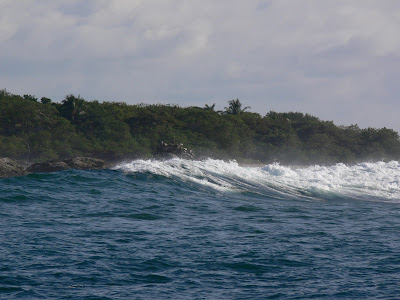+0595+P1000991.jpg)
This is my favorite crocodile photo. This was a rare chance to look upwards at a crocodile in the wild from an angle to photograph the underside of his chin.
I was so close to this crocodile that an instant after I took this photo the crocodile rushed into the river and I got splattered with mud as he dove into the water. (Yes, I did use a telephoto zoom, so I was not as close as this photo appears.)
I took this photo from a wildlife boat excursion on the Tempisque River in Palo Verde National Park. Usually the crocodiles visible on such trips are in the mud along the river banks. This crocodile was up on the river bank, and the boat operator glided the bow of the boat into the river bank so that we could watch the crocodile up close. The boat is a good size, holding 20 or so people, so there is no danger from the crocodile on the boat.
As you can see from this photo angle, the crocodile was higher in elevation than the boat. Instead of the usual crocodile photo looking down on the top of his head and back, I was able to get a shot looking up to the underside of his chin. To get the best angle, I went to the side of the boat, leaned over with my camera hanging from my neck, and held the camera as low as I could, just above the water, to get a better angle to shoot up at the crocodile.
Just after I took this photo the crocodile charged the river right next to where I was hanging out of the boat and leaning over. No, I did not get a photo of that. I bolted up from the water and retracted safely into the boat, plenty fast enough to not be in reach of the crocodile, but not fast or far enough to avoid getting splattered by the mud from the river bank kicked up by the crocodile.
In retrospect, it was stupid and dangerous to lean over the side of a boat with a camera and hands dangling just above the water. After all, if there is one crocodile in the area, there could have been another. But sometimes the desire for the best camera angle is an irresistible force that controls the movements of the photographer, at least for amateurs like me. I am sure a professional photographer, which I would love to be, would have taken a better photo in a more careful manner, but I got a photo I love, and a story to tell. And, yes, I have washed the shirt that was splattered by crocodile mud.
(I have another dangerous jungle story about the time I was on a hike in the Amazon jungle at night and was charged by a wild animal. I was able to deflect away the animal with the lighting quick reflexes of my forearm. And what aggressive, crazed, wild animal had mounted this attack on me, you might be wondering? It was an animal that is attracted to light, and my hiking companion shined a flashlight on the animal, provoking its charge. Sorry to string you along for this tease, but the wild animal that charged me was a hummingbird.)
+0387+P1000547.jpg) I am not positive, but I believe that the bird on the lower left is a yellow-crowned night heron. I make that identification based on the pattern of the black and white plumage on its head, plus its gray color, size and habitat. The yellow-crowned night heron is more often seen during the day than the black-crowned and other night herons, although they are nevertheless still primarily nocturnal.
I am not positive, but I believe that the bird on the lower left is a yellow-crowned night heron. I make that identification based on the pattern of the black and white plumage on its head, plus its gray color, size and habitat. The yellow-crowned night heron is more often seen during the day than the black-crowned and other night herons, although they are nevertheless still primarily nocturnal.
+0417+P1000569.jpg)











+0447+P1000593.jpg)






+0483+P1000689.jpg)






+IMG_3381.jpg)

+0595+P1000991.jpg)
+IMG_0768.jpg)




+0743+P1010204.jpg)

 This is the whale season in Costa Rica. I do not have any photos of whales, so I am illustrating the story with this photo taken from a boat off looking down Langosta Beach while sailing out of Tamarindo Bay.
This is the whale season in Costa Rica. I do not have any photos of whales, so I am illustrating the story with this photo taken from a boat off looking down Langosta Beach while sailing out of Tamarindo Bay.

